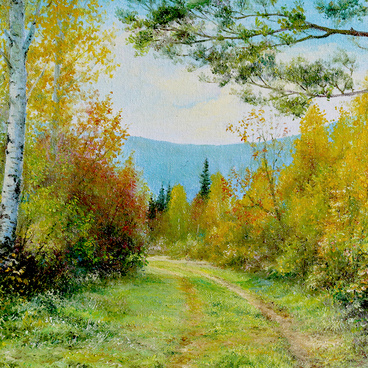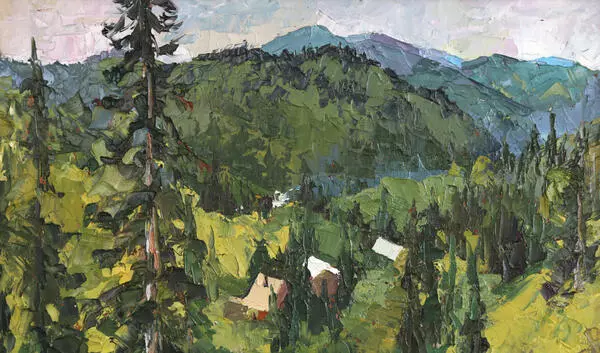Natalia Mikhailovna Petruk is a professional artist who celebrates her native region in her work.
In 1996 she graduated as from the Omsk State Pedagogical University, specializing in the teaching of art, and since then she has worked as a teacher in the Mezhdurechensk Children’s School of Art.
Natalia Petruk draws and paints. Her works include beautiful oil paintings and water colors, as well as drawings. She has experimented with a number of different genres, but landscape painting has always been her primary focus.
In this study, Amzas, the artist depicts a river scene. In the foreground we see rapids — the water foams as it rushes over the rocks. The artist uses broad, bold brush strokes to convey the swift flow of this mountain river.
The river’s winding path passes between rocky cliffs topped with luxuriant vegetation. On the left we see a tree with dense green foliage. In the distance the blue mountains and the forest form a high wall. The picture conveys an sense of the coolness and freshness of the river.
The Amzas, shown in the painting, is a right tributary of the River Tom, which winds its way between mountains and through forests. The name of the river means ‘Mother river’. The Amzas is on the western slope of the Tiger-Tysh (the Teeth of the Sky) mountain ridge. The river is approximately 19 kilometers long, with drop in elevation of some 1 100 meters over that distance.
The Kuznetsk Tatars have lived for centuries on the banks of the rivers of Mountain Shoria -such as the one depicted in the painting - and venerated the spirits which they believed inhabited the natural world around them. The Siberian forest is a harsh environment: it can provide for people’s needs in abundance, but it can also deny its gifts - the wild animals can disappear from the forest and the fish depart from the rivers and lakes.
The Shorians’ explanation for this was that the world was inhabited by many spirits - the lords of the mountains, rivers and forest, which could either help or harm people. The local people tried to appease the capricious spirits by making sacrifices and bringing them drink and other presents.
In their myths, the Shorians told how the spirit of the waters could be seen at the time of drifting ice. The spirit resembles a black horned animal. According to another myth, the ‘lady of the waters may appear to people in the form of a naked woman with long golden hair.’ The Shorian hunters told tales of the lord of the forests. ‘At night, in the forest, you may suddenly hear a song, as if someone is playing a melody. That is the lord of the forest, enjoying himself. The spirit of the forest may walk around a hunter’s shelter, and knock, but the hunter must not come out. Or the spirit may prowl around the shelter trying to frighten the hunter by shouting, roaring, or calling his name three times. But the hunter must be quiet, or the spirit will steal him away, and when the hunter return home he will have to perform a shamanistic ritual and ask for his soul back.’
In this painting Natalia Petruk displays her gift for depicting the fantastic, mysterious and harsh beauty of Siberia’s nature.
In 1996 she graduated as from the Omsk State Pedagogical University, specializing in the teaching of art, and since then she has worked as a teacher in the Mezhdurechensk Children’s School of Art.
Natalia Petruk draws and paints. Her works include beautiful oil paintings and water colors, as well as drawings. She has experimented with a number of different genres, but landscape painting has always been her primary focus.
In this study, Amzas, the artist depicts a river scene. In the foreground we see rapids — the water foams as it rushes over the rocks. The artist uses broad, bold brush strokes to convey the swift flow of this mountain river.
The river’s winding path passes between rocky cliffs topped with luxuriant vegetation. On the left we see a tree with dense green foliage. In the distance the blue mountains and the forest form a high wall. The picture conveys an sense of the coolness and freshness of the river.
The Amzas, shown in the painting, is a right tributary of the River Tom, which winds its way between mountains and through forests. The name of the river means ‘Mother river’. The Amzas is on the western slope of the Tiger-Tysh (the Teeth of the Sky) mountain ridge. The river is approximately 19 kilometers long, with drop in elevation of some 1 100 meters over that distance.
The Kuznetsk Tatars have lived for centuries on the banks of the rivers of Mountain Shoria -such as the one depicted in the painting - and venerated the spirits which they believed inhabited the natural world around them. The Siberian forest is a harsh environment: it can provide for people’s needs in abundance, but it can also deny its gifts - the wild animals can disappear from the forest and the fish depart from the rivers and lakes.
The Shorians’ explanation for this was that the world was inhabited by many spirits - the lords of the mountains, rivers and forest, which could either help or harm people. The local people tried to appease the capricious spirits by making sacrifices and bringing them drink and other presents.
In their myths, the Shorians told how the spirit of the waters could be seen at the time of drifting ice. The spirit resembles a black horned animal. According to another myth, the ‘lady of the waters may appear to people in the form of a naked woman with long golden hair.’ The Shorian hunters told tales of the lord of the forests. ‘At night, in the forest, you may suddenly hear a song, as if someone is playing a melody. That is the lord of the forest, enjoying himself. The spirit of the forest may walk around a hunter’s shelter, and knock, but the hunter must not come out. Or the spirit may prowl around the shelter trying to frighten the hunter by shouting, roaring, or calling his name three times. But the hunter must be quiet, or the spirit will steal him away, and when the hunter return home he will have to perform a shamanistic ritual and ask for his soul back.’
In this painting Natalia Petruk displays her gift for depicting the fantastic, mysterious and harsh beauty of Siberia’s nature.




